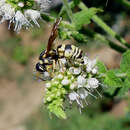en
names in breadcrumbs


The Strepsiptera (twisted-wing parasites) are a group of insects. The approximately 600 species in this order are all obligate parasites of other insects. Strepsipterans have extreme sexual dimorphism. The short-lived males are free-living and winged. The forewings are greatly reduced and haltere-like (Pix et al. 1993) while the hindwings are large and fan-shaped. The males' antennae are large and branched, and the eyes are raspberry-like with a small number of large ommatidia (Kinzelbach 1971, 1990, Kathirithamby 1989). All known strepsipteran females are wingless and resemble larvae to some degree (Kathirithamby 1989). In the suborder Mengenillidia, the females are free-living and have small eyes, mouthparts, and legs. However, in the suborder Stylopidia, females are totally endoparasitic within the host and completely lack the external characteristics typical of adult insects (Kathirithamby 1989).
Twisted-wing parasites gets their common name from resting males, because the wings are laid at an odd angle.The females do not have wings and sometimes do not have legs either. Parasitic Strepsiptera go through hypermetamorphosis, which means they have larvae that have the motor skills to find a host. The larvae are called triungulins and find their way to a host after leaving a female. They look for wasps, planthoppers, bees, leafhoppers, and other insects to in habit. Inside the host, the larva molts and resembles a worm at this stage.It molts a few more times and then pupates inside its larval skin.After the male emerges, he exists the host and looks for other females.The female stays inside her host and releases a pheromone to attract a male. The adult males will usually live around five hours before dying.They do not eat and use their mouth as a sensory structure instead.They fly around until they find a host that is emitting a female’s pheromone.The females die after the larvae are produced. Order Strepsiptera can be found throughout the world.